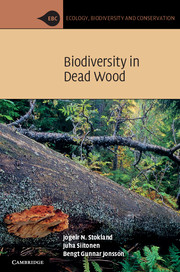Book contents
- Frontmatter
- Contents
- Preface
- 1 Introduction
- 2 Wood decomposition
- 3 The saproxylic food web
- 4 Other associations with dead woody material
- 5 Host-tree associations
- 6 Mortality factors and decay succession
- 7 Microhabitats
- 8 Tree size
- 9 The surrounding environment
- 10 Evolution of saproxylic organisms
- 11 Species diversity of saproxylic organisms
- 12 Natural forest dynamics
- 13 Dead wood and sustainable forest management
- 14 Population dynamics and evolutionary strategies
- 15 Threatened saproxylic species
- 16 Dead wood in agricultural and urban habitats
- 17 The value and future of saproxylic diversity
- References
- Index
7 - Microhabitats
Published online by Cambridge University Press: 05 June 2012
- Frontmatter
- Contents
- Preface
- 1 Introduction
- 2 Wood decomposition
- 3 The saproxylic food web
- 4 Other associations with dead woody material
- 5 Host-tree associations
- 6 Mortality factors and decay succession
- 7 Microhabitats
- 8 Tree size
- 9 The surrounding environment
- 10 Evolution of saproxylic organisms
- 11 Species diversity of saproxylic organisms
- 12 Natural forest dynamics
- 13 Dead wood and sustainable forest management
- 14 Population dynamics and evolutionary strategies
- 15 Threatened saproxylic species
- 16 Dead wood in agricultural and urban habitats
- 17 The value and future of saproxylic diversity
- References
- Index
Summary
Both living and dead trees provide a number of distinct microhabitats for saproxylic species. By ‘microhabitats’ we mean discrete parts of a tree that host different species assemblages. Some of the microhabitats are only present in living trees, typically in mature or old individuals (Figure 7.1), and additional ones become available after the trees die. Wounds, rot holes and cavities; attached dead branches and roots; phloem (inner bark), sapwood and heartwood; fruiting bodies and mycelia of decomposer fungi etc. each host very different species assemblages. In this chapter, we describe in more detail the various dead-wood microhabitats, and the many ways in which saproxylic species can be dependent on their particular microenvironments. We present the microhabitats in the order in which they appear in a tree, starting from wounds and sap exudations that can occur even in young trees, followed by cavities and other microhabitats that develop as a result of decay in mature living trees, and ending with those microhabitats, such as subcortical space, that become available only after a tree has died. Some microhabitats, especially sap exudations and cavities, are far more common in broadleaved than in coniferous trees.
Wounds and sap exudations in living trees
Many factors can cause injuries to trees. Mechanical damage includes branch and stem breakages by wind, wounds made by falling trees hitting adjacent trees, lightning strikes, fire scars, frost cracks and snow breakage. Pathogenic fungi and bacteria can create necrotic patches, termed cankers, in the phloem layer. Most of the fungi that induce cankers kill the phloem and do not bring about sap flows. ‘Bleeding cankers’ are generally caused either by bacteria (Schmidt et al., 2008) or by Phytophthora species (Oomycetes) (Brown and Brasier, 2007) and produce only small amounts of exudates. Some vertebrate species, such as woodpeckers, and many invertebrate species can injure the bark, which may result in sap exudation and provide an opportunity for microbial colonization. For instance, cicadas (Hemiptera: Cicadidae) are known to cause sap exudation by piercing the bark with their stylet-like mouthparts to feed on sap (Yamazaki, 2007), and carpenterworm (Lepidoptera: Cossidae) larvae can initiate and maintain sap exudation by gnawing the bark (Yoshimoto and Nishida, 2007).
- Type
- Chapter
- Information
- Biodiversity in Dead Wood , pp. 150 - 182Publisher: Cambridge University PressPrint publication year: 2012
- 15
- Cited by



